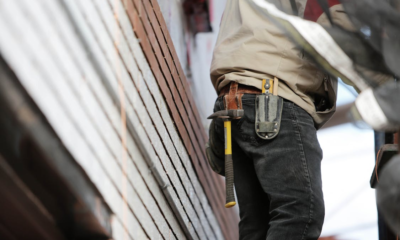Tech
Metal Additive Manufacturing: A Deep Dive into 3D Printed Metal Parts
Published
1 year agoon

Introduction: Metal additive manufacturing, commonly known as 3D printing, has emerged as a transformative technology in the manufacturing industry. With the ability to produce complex metal parts directly from digital designs, 3D printing offers numerous advantages over traditional manufacturing methods. This article provides a comprehensive exploration of metal additive manufacturing, its applications, benefits, and considerations.
Custom 3D printing refers to the process of creating personalized and unique objects using 3D printing technology. With custom 3D printing, individuals and businesses can bring their specific designs and ideas to life, tailoring products to their exact requirements. Whether it’s customized jewelry, personalized home decor, or bespoke prototypes, custom 3D printing offers endless possibilities. It allows for the creation of one-of-a-kind items that reflect individual preferences, tastes, and needs. By leveraging the capabilities of 3D printing, custom manufacturing becomes more accessible, efficient, and affordable, empowering creativity and innovation in various fields.
The Process of Metal Additive Manufacturing
Metal additive manufacturing involves the layer-by-layer deposition of metal powder or wire to build a three-dimensional object. There are several techniques employed in metal 3D printing, including selective laser melting (SLM), electron beam melting (EBM), and binder jetting. SLM and EBM utilize high-energy sources such as lasers or electron beams to melt and fuse metal powders, while binder jetting combines a powdered metal material with a binding agent to create green parts that require additional post-processing steps.
Applications of 3D Printed Metal Parts
Metal 3D printing has found applications in various industries, including aerospace, automotive, healthcare, and tooling. It enables the production of complex geometries, lightweight structures, and parts with integrated functionalities. In aerospace, 3D-printed metal components are used in engine parts, brackets, and prototypes, leading to weight reduction and improved fuel efficiency. In healthcare, customized implants, prosthetics, and surgical tools are fabricated using metal additive manufacturing, offering patient-specific solutions and improved surgical outcomes.
Benefits of Metal Additive Manufacturing
Metal additive manufacturing offers several advantages over traditional manufacturing methods:
A. Design Freedom: 3D printing allows the creation of highly complex geometries and intricate designs that are difficult or impossible to achieve with traditional methods. This enables lightweight, improved performance, and innovative product designs.
B. Cost Efficiency: Metal 3D printing reduces material waste since parts are built layer by layer. Additionally, it eliminates the need for complex tooling and molds, reducing upfront costs, especially for low-volume production.
C. Customization and Personalization: 3D printing enables the production of customized metal parts tailored to specific requirements. This is particularly valuable in industries like healthcare, where patient-specific implants and prosthetics are needed.
D. Faster Prototyping and Production: With 3D printing, metal prototypes, and small-batch production can be achieved rapidly, allowing for faster iteration, testing, and validation of designs.
Considerations in Metal Additive Manufacturing
While metal additive manufacturing offers numerous benefits, there are some considerations to keep in mind:
A. Material Selection: The choice of metal material is critical and depends on the specific application requirements. Different metals have varying properties, such as strength, corrosion resistance, and thermal conductivity, which should align with the intended use of the part.
B. Post-Processing and Finishing: 3D printed metal parts often require post-processing to remove support structures, improve surface finish, and achieve desired tolerances. Processes such as heat treatment, machining, and polishing may be necessary to achieve the desired final product.
C. Quality Control and Certification: Ensuring the quality and reliability of 3D-printed metal parts is essential, particularly in industries with stringent regulations. Quality control measures, non-destructive testing, and certification processes should be implemented to meet industry standards and ensure part integrity.
Calculate 3D Printing Cost: Factors to Consider
Calculate 3D printing cost involves considering several factors, including material usage, machine time, and any additional post-processing requirements. The cost of the material is typically determined by the volume or weight of the object being printed. Machine time is calculated based on the duration of the print job and the hourly rate of the 3D printer.
Additional costs may arise from support material, finishing processes, and any required design modifications. Some 3D printing service providers offer online calculators that estimate the cost based on these factors. Ultimately, the specific details of the project, such as size, complexity, and quantity, will influence the final cost of 3D printing.
Conclusion
Metal additive manufacturing has revolutionized the manufacturing industry by enabling the production of complex, lightweight, and customized metal parts. The design freedom, cost efficiency, and rapid prototyping capabilities of 3D printing have opened up new possibilities for various sectors. However, material selection, post-processing, and quality control remain crucial considerations in ensuring the reliability and performance of 3D-printed metal parts.
Recent News


4 Amazing Trips for Your Family
Choosing somewhere for a family vacation that would pique the attention of adults and kids alike can be a fun...


Customising Your Makeup with Blendable Blush Options
In cosmetics, one’s face is a canvas for self-expression and creativity. Among the myriad of products available, blush is a...


The Benefits of Regular Home Maintenance
Regular home maintenance is essential for maintaining and even raising the value of your house. A proactive approach to repairs...


Understanding the Importance of SEO in Adelaide
In the digital marketplace, Adelaide businesses are in a continuous contest to gain the attention of their target audiences. With...


Breaking Down the Numbers: Understanding the Average Traveling Nurses Pay
The open road, adventure, and the chance to heal – travel nursing promises an undeniable allure. But amidst the excitement,...


Dealing with Oily Skin in Summer: Tips and Tricks
As the temperature rises, those with oily skin often face an additional challenge—maintaining a clear and balanced complexion. Excess oil...


Mountain Wedding Ideas for 2024
A mountain wedding is a stunning choice for couples who cherish nature and desire a distinctive wedding experience. Whether you...


3 Of The Best Ways To Keep Your Salon Clean
It is of the utmost importance to ensure that a salon is kept scrupulously clean, not just for the sake...


3 Reasons You Should Get Blood Tests Every Year
Regular blood tests are essential for preserving general health and identifying potential problems early on. Medical professionals can evaluate your...


How to Make Your Next Crafts Project Pop
Crafting is a creative outlet that allows individuals to express themselves through various mediums such as paper crafts, sewing, painting,...
